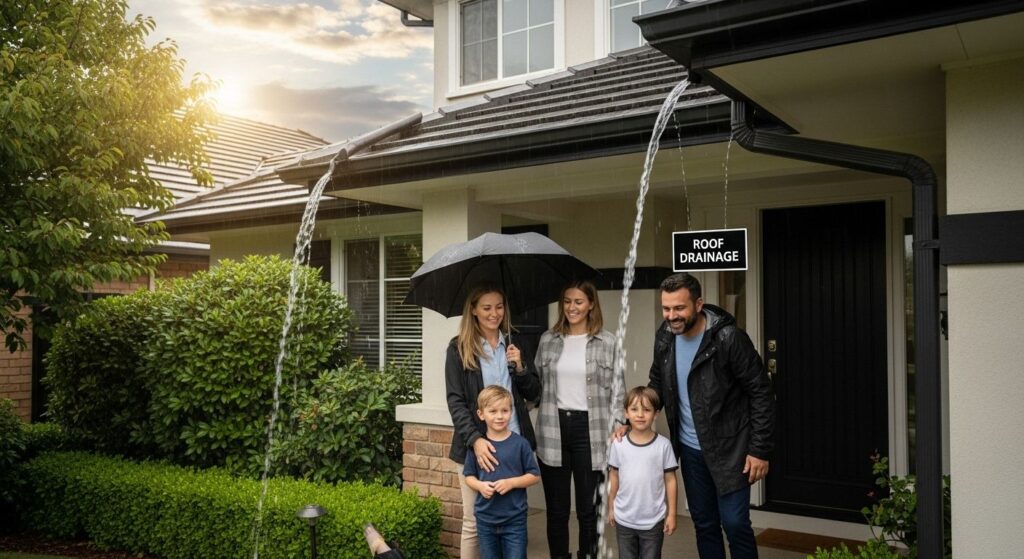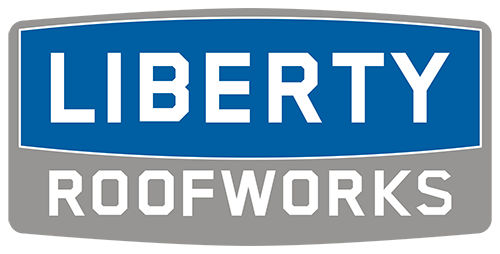
Roof drainage might look simple but it quietly shields your home from massive trouble. Just one inch of rainfall can pour over 1,200 gallons of water onto the roof of an average house. Most people worry about storms or leaks, yet the biggest threat could be water that sticks around on your roof and slowly destroys it from the inside out. The real danger usually starts when drainage fails in ways you never expected.
Table of Contents
- What Is Roof Drainage And Its Importance?
- How Roof Drainage Works: Key Components Explained
- The Impact Of Proper Roof Drainage On Property Health
- Common Roof Drainage Issues And Their Consequences
- Best Practices For Maintaining Effective Roof Drainage
Quick Summary
| Takeaway | Explanation |
|---|---|
| Invest in a comprehensive roof drainage system. | A well-designed drainage system protects your home from structural damage caused by water accumulation. |
| Regularly inspect and clean gutters and downspouts. | Seasonal maintenance prevents clogs and ensures efficient water flow away from your home. |
| Understand the important components of drainage. | Key elements include roof surface, gutters, downspouts, and roof slopes that manage water effectively. |
| Address drainage problems early to avoid damage. | Identifying issues like clogged gutters or inadequate slope can prevent costly repairs and structural risks. |
| Enhance drainage efficiency with upgrades. | Consider installing gutter guards and improving grading to improve water redirection and foundation protection. |
What is Roof Drainage and Its Importance?
Roof drainage represents a critical system that protects your home from water damage by efficiently managing rainwater and melting snow. Without proper drainage, water can accumulate on your roof, leading to significant structural problems and expensive repairs.
Understanding Roof Drainage Mechanics
At its core, roof drainage is a network of components designed to channel water away from your home’s structure. This system typically includes gutters, downspouts, drains, and strategic roof slopes that guide water toward designated collection points. According to the U.S. Environmental Protection Agency, effective water management is essential for preventing potential building damage.
The primary goals of roof drainage include:
- Preventing water accumulation that can cause structural weakening
- Protecting the roof’s integrity and preventing premature deterioration
- Reducing moisture that could lead to mold and mildew growth
- Maintaining the overall foundation stability of your home
Why Roof Drainage Matters for Homeowners
Proper roof drainage goes beyond simple water redirection. It serves as a critical defense mechanism against potential water-related damages. When water is not effectively channeled away, it can seep into roofing materials, compromise structural integrity, and create expensive repair scenarios.
Homeowners should understand that inadequate drainage can lead to multiple serious issues, such as:
- Foundation erosion
- Basement flooding
- Roof material degradation
- Wood rot and structural weakening
By investing in a well-designed roof drainage system, you protect your home from these potential costly damages. Learn more about protecting your roof’s drainage system.
How Roof Drainage Works: Key Components Explained
Roof drainage is a sophisticated system that involves multiple interconnected components working together to protect your home from water damage. Understanding these key elements helps homeowners appreciate the complexity and importance of an effective drainage network.
To help homeowners quickly identify the main parts of an effective roof drainage system and their roles, the following table outlines the key components described in the guide.
| Component | Function |
|---|---|
| Roof Surface | Collects rainwater and melting snow |
| Gutters | Channels water from roof edges |
| Downspouts | Directs water from gutters to the ground |
| Drainage Slopes | Ensures water flows toward collection points |
Each component plays an essential role in preventing water accumulation and ensuring your home stays protected from moisture damage.
Primary Drainage System Components
The roof drainage system consists of several critical elements designed to efficiently redirect water away from your home’s structure. According to the National Park Service, these components work in a precise sequence to manage water flow.
The essential components include:
- Roof Surface: The initial collection point for rainwater and melting snow
- Gutters: Horizontal channels that collect and direct water from the roof edges
- Downspouts: Vertical pipes that transfer water from gutters to ground level
- Drainage Slopes: Strategically angled roof surfaces that guide water toward collection points
Water Flow Dynamics
Water moves through the drainage system using gravity and carefully engineered angles. Roof pitch plays a crucial role in determining how quickly and effectively water is channeled away. Steeper roofs typically allow faster water runoff, while flatter roofs require more sophisticated drainage solutions.
The drainage process involves multiple stages:
- Initial water collection on the roof surface
- Channeling through gutters and downspouts
- Dispersal away from the home’s foundation
- Preventing potential water accumulation and structural damage
Learn more about maintaining your roof’s drainage system to ensure long-term home protection and prevent costly water-related repairs.
The Impact of Proper Roof Drainage on Property Health
Roof drainage extends far beyond simple water management. It represents a critical defense mechanism that protects your entire property from potential structural and environmental damage. Homeowners who understand this connection can prevent costly repairs and maintain their home’s long-term integrity.
Foundation and Structural Protection
Water mismanagement can devastate a home’s foundational structure. According to Purdue University Cooperative Extension Service, improper roof drainage can lead to significant structural challenges that compromise building stability.
The potential risks include:
- Soil erosion around the home’s perimeter
- Foundation wall cracking
- Basement moisture and potential flooding
- Compromised structural integrity
Long-Term Property Preservation
Effective roof drainage systems act as a critical protective barrier for your property. By efficiently channeling water away from critical structural points, these systems prevent moisture-related deterioration that can occur gradually and often go unnoticed until significant damage has already happened.
Key preservation benefits include:
- Preventing wood rot in structural elements
- Reducing mold and mildew growth
- Protecting exterior paint and siding
- Maintaining landscape integrity around the home
Discover how proper roof maintenance protects your property, ensuring your home remains a safe and sound investment for years to come.
Common Roof Drainage Issues and Their Consequences
Roof drainage problems can quickly escalate from minor inconveniences to major structural threats. Recognizing and addressing these issues early can save homeowners significant time, money, and potential property damage.
For an at-a-glance overview, this table summarizes common roof drainage issues discussed in the article and the potential consequences if they are not resolved.
| Common Issue | Potential Consequence |
|---|---|
| Clogged Gutters | Prevents proper water flow, causes overflow |
| Inadequate Roof Slope | Leads to water retention and ponding |
| Blocked Downspouts | Disrupts water redirection |
| Damaged Components | Compromises entire drainage system |
| Ponding Water | Increases risk of structural complications |
Identifying and addressing these issues early can help you avoid costly structural damage and maintain a safe home environment.
Identifying Critical Drainage Challenges
Ponding water represents one of the most significant drainage problems homeowners face. According to research from Penn State University, persistent water accumulation can lead to severe structural complications.
The most prevalent drainage issues include:

- Clogged Gutters: Preventing proper water flow
- Inadequate Roof Slope: Causing water retention
- Blocked Downspouts: Disrupting water redirection
- Damaged Drainage Components: Compromising entire water management system
Potential Structural and Environmental Risks
Unresolved drainage problems can create cascading damage throughout your property. Water that cannot effectively drain can penetrate roofing materials, compromise structural integrity, and create environments conducive to mold and rot.
The potential consequences of poor drainage are extensive:
- Foundation weakening and potential cracking
- Basement moisture and flooding risks
- Landscape erosion around property perimeter
- Increased potential for wood rot and structural decay
Learn more about preventing roof drainage complications to protect your home from potential long-term damage.
Best Practices for Maintaining Effective Roof Drainage
Proper roof drainage maintenance is not just a recommendation but a critical strategy for protecting your home’s structural integrity. Homeowners who implement regular drainage care can significantly extend their roof’s lifespan and prevent costly water-related damages.
Routine Inspection and Cleaning
According to Purdue University Extension, consistent maintenance is key to preventing drainage complications. Regular inspections allow homeowners to identify and address potential issues before they escalate into significant problems.
Critical maintenance practices include:
- Seasonal Gutter Cleaning: Removing leaves, debris, and potential blockages
- Downspout Clearance: Ensuring unobstructed water flow
- Checking Roof Slope: Verifying proper water channeling
- Examining Drainage Components: Looking for signs of wear or damage
Strategic Drainage System Improvements
Proactive enhancements can dramatically improve your roof’s drainage efficiency. This involves not just cleaning but strategically upgrading your drainage infrastructure to handle water management more effectively.
Key improvement strategies encompass:

- Installing gutter guards to prevent debris accumulation
- Adding extension pipes to direct water further from foundation
- Ensuring proper grading around your home’s perimeter
- Considering professional drainage system assessments
Explore advanced drainage protection techniques to safeguard your home against potential water damage and costly repairs.
Protect Your Home: Get Expert Roof Drainage Solutions in Charlotte
If you are concerned about standing water on your roof, clogged gutters, or unexpected leaks, you are not alone. The article you just read explains how poor roof drainage can lead to foundation erosion, mold growth, and costly structural damage. Too many homeowners find out too late that a neglected drainage system puts their entire property at risk. At Liberty Roofworks, we know exactly what it takes to design and maintain effective roof drainage for every home and business in Charlotte.
Trust our expert team to address key drainage issues quickly so you avoid expensive repairs down the road. Whether you need a minor repair or a complete roof replacement, we offer reliable solutions that help you keep water where it belongs: outside your home. Start protecting your property right now—visit Liberty Roofworks or learn how proactive maintenance stops drainage problems before they start. Take the first step toward a safer, healthier home today.
Frequently Asked Questions
What is roof drainage, and why is it important for my home?
Roof drainage is a system designed to manage rainwater and melting snow effectively, preventing water accumulation on your roof. It is important because inadequate drainage can lead to severe structural damage, including foundation erosion, mold growth, and premature deterioration of roofing materials.
What are the key components of a roof drainage system?
The key components include roof surfaces that collect water, gutters that channel water away from the roof edges, downspouts that direct water down to the ground, and drainage slopes that guide the water toward collection points. Together, these components ensure efficient water management.
How can I maintain my roof drainage system?
To maintain your roof drainage system, conduct routine inspections and cleaning of gutters and downspouts, ensure proper roof slope, and examine drainage components for wear or damage. Regular maintenance helps prevent costly water-related damages.
What are common issues that can arise with roof drainage?
Common issues include clogged gutters, inadequate roof slope, blocked downspouts, and damaged drainage components. These problems can lead to ponding water, structural damage, and increased risks of mold and rot in your home.
